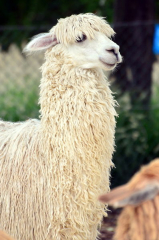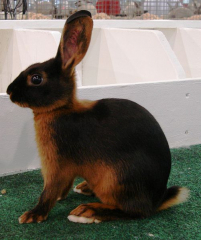I haven’t been to many rural shows. My first, really, was the Perth Royal Show last year – although I’ve been to the Royal Show before, it’s been for the carnival and the rides rather than the animals. Last year I figured, we’re starting a farm, I’ll look at the livestock. Actually, I only intended to look at the chickens and pigeons, and the cats. I ended up also checking out the alpacas, goats, and cattle.
I went to my second show on Saturday, and my third on Sunday. Saturday was the 2013 Colourbration alpaca show, which I wanted to attend because I’m thinking semi-seriously about keeping a few alpacas for their wool and meat, and not all the breeders in WA have an online presence. I chatted to a lovely lad from Taylors Alpacas, who let me pet two of her animals. Touching the suri alpacas is like stroking a piece of warm, living silk. It really is, no exaggeration. The huacayas are soft and fluffy, but the suris feel like water.
I didn’t realise that the alpacas don’t suffer from the heat in Perth in the summer, even if they haven’t been shorn. I assumed they were shorn in spring like sheep partially to keep them form overheating in summer, but apparently not. Their wool insulates them, and they’ll happily lie out in the sun on 40 degree days. The suris are often only shorn every second year, as their fleece doesn’t grow enough in a single year to make it worth shearing them. I also didn’t know that alpacas put their ears down and back when they’re nervous, and raise their tails up when they’re friendly and happy.
Although it was freezing cold, I really enjoyed the show. It was well laid out, and all the stalls were labeled with the name of the stud that owned the animals. There was even a stand selling alpaca burgers, although none were ready before I left, and alpaca leather products. A few breeders are trying to start up an alpaca meat industry in Australia, because keeping livestock just for the wool doesn’t make financial sense. I’ve eaten alpaca before, in South America, and it’s pretty tasty. Lean, mild flavoured red meat, a bit like veal or rabbit. I did get the name of the abattoir they use, which is open to taking single animals (this is a rarity in WA, and worth noting down for later).
Sunday was a different story, though. On Sunday I went to the WA Rabbit Association’s show, in the hopes of seeing in person some of the breeds I’m interested in. I’m planning a cross-breeding experiment to produce largish meat rabbits with both the satin (shiny, deeply coloured) and rex (very short, plush, velvety textured) fur types. My foundation breeds will be the Standard Rex and the Satin, obviously, but also either a British Giant or Flemish Giant, and possibly a Tan, for the colour (I think the tan markings are beautiful, and if you’re going to raise livestock you should always go with something you like the look of if you can) and also to inject a slightly different body shape. I’m aiming for a good meat rabbit conformation, but with more of an arch than many of the modern meat breeds. Also, a wider variety of genetics means healthier kits.
The show was tiny, or it seemed tiny. There were probably almost as many rabbits as there were alpacas at the Colourbration show, but because they’re smaller, and the cages were stacked, it seemed much smaller. None of the cages were labeled, with the variety or the stud name, so identifying the breeders was tough. It was crowded, because the room was too small for the number of people and animals, and it didn’t seem like they were expecting many people to turn up aside form the breeders and possibly their families.
Don’t get me wrong, everyone was friendly and lovely, but it was pretty tough to find any information. Clearly, rabbits are not a big enough thing in WA to have the type of organisation that alpacas demand.
Images sourced from Wikimedia Commons:
File:50_Jahre_Knie%27s_Kinderzoo_-_Vicugna_pacos_%28Alpaka%29_2012-10-03_16-14-49.JPG
File:State_fair_06_029.jpg

